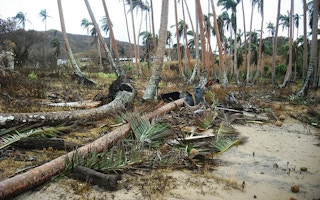When Cyclone Winston hit Fiji on 20 February, killing more than 40 people and leaving 112,800 homeless, scientists questioned if these extreme weather incidents can be attributed to climate change and how to better prepare small islands for severe weather.
With winds of up to 330 kilometres per hour, Cyclone Winston was one of the world’s most powerful storms ever to hit land, spurring the UN to seek more than US$38 million to help the victims.
Karen McNamara, senior lecturer at the University of Queensland, says that “with 350,000 people effected…the subsequent destruction of Cyclone Winston will mean extensive re-building of the 24,000 houses that were destroyed, critical public infrastructure, along with the replanting of life-sustaining crops and provision of crucial livelihood assets.”
But there is no clear evidence for a long-term rising trend in tropical cyclone frequency or intensity in the region around Fiji, says Thomas Knutson, research meteorologist at the Geophysical Fluid Dynamics Laboratory of the National Oceanic and Atmospheric Administration of the United States.
Knutson tells SciDev.Net that this is in contrast to sea surface temperatures, which have warmed over the past century in the Pacific region as they have globally.
“While it is possible climate change may be affecting tropical cyclone activity, I do not see a strong indication of this from either long observational records of tropical cyclone activity or the tropical cyclone/climate change modelling work we have done,” he says.
Storm behaviour was explored using climate model scenario experiments for the late twenty-first century, which tested with much higher sea surface temperatures than have to date been recorded.
Based on these experiments, it is likely that future tropical cyclones around the globe will be more intense by the late twenty-first century than they are in the present climate, with a projected increase of about five per cent, Knutson elaborates.
He adds, however, that the southwest Pacific basin region in which Fiji is located is not projected to have stronger tropical cyclones based on future tropical cyclone simulations.
On the preparedness of island residents to extreme weather, Patrick Nunn, geography professor at the University of the Sunshine Coast in Queensland, Australia, identifies two problems: “First is the rapid loss of traditional knowledge around coping with disasters (a result of globalisation) and second is the increased severity of some cyclones.”
According to Nunn, many documented “traditional” adaptations to extreme weather have in the past aided in extreme weather preparedness for small island residents. These include traditional early-warning systems, building techniques and the deliberate planting of “cyclone crops” to eat in the aftermath.
However, modern external interventions for disaster risk reduction, climate change or biodiversity conservation, while well meaning, have caused little sustained impact.
“I don’t think it is possible to ‘cyclone-proof’ rural communities in poorer countries,” Nunn says. “The best step is for every community to have a sage (dependable leader) and practical cyclone-response plan.”










